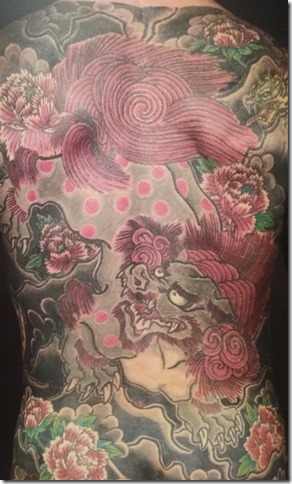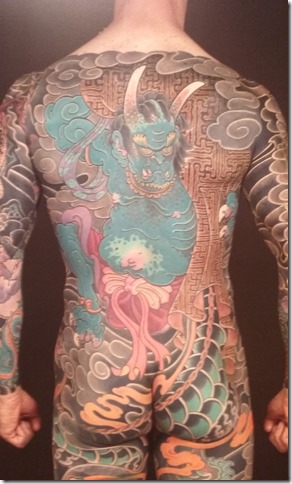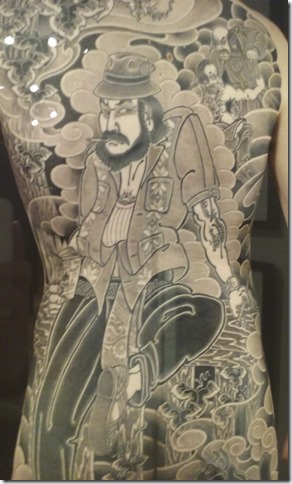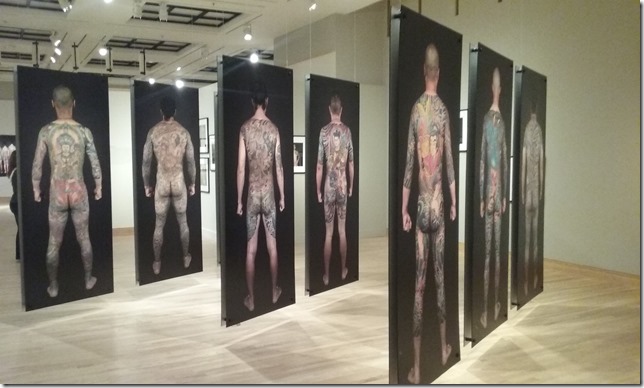Forget the butterfly, the thorny vine and the heart with initials. Imagine a colorful bird with a fish’s tail, a snake’s neck, and a turtle’s shell expanding from the neck all the way to the ankles. That’s what you can expect to see now at the Morikami Museum and Japanese Gardens.
Perseverance: Japanese Tattoo Tradition in a Modern World features photographs of full body tattoos bursting with skill, history and symbolism. The intricate works by seven tattoo artists, including Horitaka, Junii, and Yokohama Horiken, perfectly demonstrate why irezumi (Japanese tattoo) commands respect. It’s not just its association with the yakuza. Along with the geisha, the tea ceremony and the samurai, irezumi preserves a certain enigma, an air of mystery. No other country’s tattoos are feared and admired at the same time.
The photographs, shot by Kip Fulbeck, who also designed the show, are grouped according to the traditional symbols and motifs starring in the tattoos. In their presence, we get the feeling of looking at something forbidden. Dragons, tigers, lions, carp and cherry blossoms appear in vivid colors spreading over arms, thighs, calves and butt cheeks. As we walk the gallery, each group brags about the skill displayed, and we get to learn about the myth or legend driving it. It’s a win-win.
The phoenix-like creature described earlier on is both male and female and stands as a symbol of happiness and good luck. Two koi together represent a happy marriage, while a single koi battling waves and swimming up a waterfall, represents success and strength. To the samurai, the sakura symbolized the renewal of life. Meanwhile, the dragon was worshipped by farmers who viewed it as the god of the sea and thus could ensure rainfall.
Surviving despite the passing of time no doubt has earned irezumi some credit. But the strongest proof that Japanese tattoos are indeed an art form is the fact that they have not only endured, but inspired new interpretations. Many non-Japanese tattoo artists have found them worthy of being studied and copied and re-imagined. Among them is Chris Horishiki Brand, who is featured in the show.
Borrowing from the classic Chinese novel Shui Hu Zhuan (Suikoden, in Japanese) and its rebel protagonists, Brand re-imagined these bandits in a contemporary Chicano setting. His series 108 Heroes of Los Angeles follows the original text but the clothing and weaponry are visibly modern and far from traditional Japanese. One of his backpieces features a man sporting jeans and Converse sneakers.
Without trust and pain, artists like him could never have finished the artworks depicted on these flesh canvases. The artist must work hard to arrive at a design and then nail that design to the client’s satisfaction. The client, who undergoes pain for days at a time, has to surrender to the process and have faith in the artist.
Compared to its sibling traditions, irezumi still enjoys significantly less praise. But locked in the silhouettes of these dragons, screaming warriors, and lively fins is fierce determination. This is a beautiful and stubborn practice determined to stay and outlive the criticism and the negative connotations in order to be celebrated one day as an art form, which is why Perseverance is really the perfect name for the show. It captures the one thing its goal depends on.
Perseverance: Japanese Tattoo Tradition in a Modern World runs through May 8 at the Morikami Museum and Japanese Gardens, 4000 Morikami Park Road, Delray Beach. Museum hours are 10 a.m. through 5 p.m. from Tuesday through Sunday. Admission: $15 adults, $13 seniors and military; $9 children ages 6-17. Call 561-495-0233 or visit www.morikami.org for more information.



